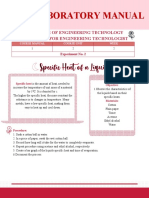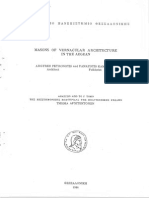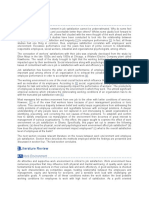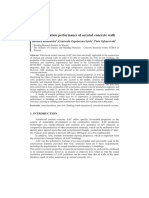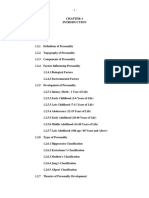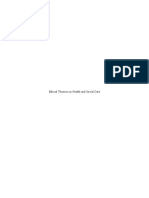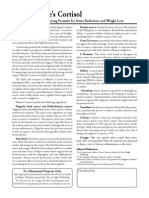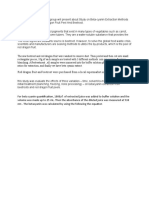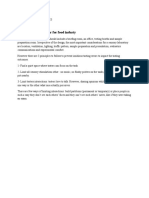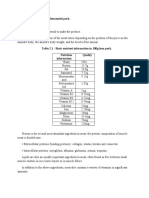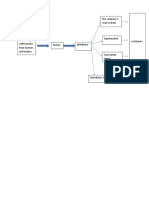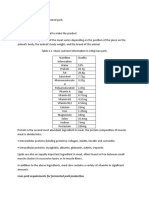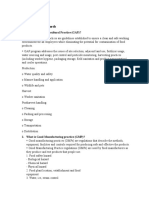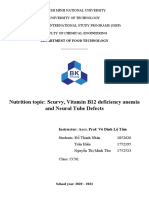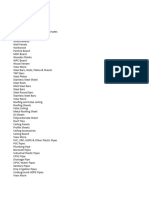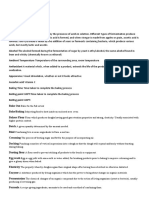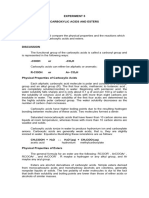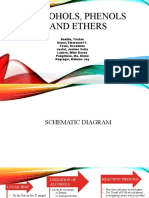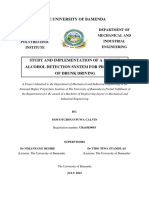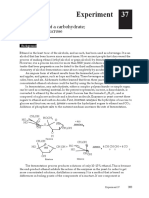Yomeishu Contains 14
Uploaded by
Nguyễn ThuYomeishu Contains 14
Uploaded by
Nguyễn ThuQuality
Cinnamomi cortex
Although available throughout the year, the fragrant, sweet and warm taste of cinnamon is a perfect
spice to use during the winter months.
Cinnamon has a long history both as a spice and as a medicine. It is the brown bark of the cinnamon
tree, which is available in its dried tubular form known as a quill or as ground powder.
Cinnamon's unique healing abilities come from three basic types of components in the essential oils
found in its bark. These oils contain active components called cinnamaldehyde, cinnamyl acetate,
and cinnamyl alcohol, plus a wide range of other volatile substances.
Anti-Clotting Actions
Cinnamaldehyde (also called cinnamic aldehyde) has been well-researched for its effects on blood
platelets. The cinnaldehyde in cinnamon helps prevent unwanted clumping of blood platelets. (The
way it accomplishes this health-protective act is by inhibiting the release of an inflammatory fatty
acid called arachidonic acid from platelet membranes and reducing the formation of an inflammatory
messaging molecule called thromboxane A2.) Cinnamon's ability to lower the release of arachidonic
acid from cell membranes also puts it in the category of an "anti-inflammatory" food that can be
helpful in lessening inflammation.
Blood Sugar Control
Cinnamon slows the rate at which the stomach empties after meals, reducing the rise in blood sugar
after eating.
Cinnamon may also significantly help people with type 2 diabetes improve their ability to respond to
insulin, thus normalizing their blood sugar levels. Both test tube and animal studies have shown that
compounds in cinnamon not only stimulate insulin receptors, but also inhibit an enzyme that
inactivates them, thus significantly increasing cells' ability to use glucose. Studies to confirm
cinnamon's beneficial actions in humans are currently underway with the most recent report coming
from researchers from the US Agricultural Research Service, who have shown that less than half a
teaspoon per day of cinnamon reduces blood sugar levels in persons with type 2 diabetes.
Cinnamon's Scent Boosts Brain Function
Not only does consuming cinnamon improve the body's ability to utilize blood sugar, but just smelling
the wonderful odor of this sweet spice boosts brain activity!
Calcium and Fiber Improve Colon Health and Protect Against Heart Disease
In addition to its unique essential oils, cinnamon is an excellent source of fiber and the trace mineral
manganese while also a very good source of calcium. The combination of calcium and fiber in
cinnamon is important and can be helpful for the prevention of several different conditions. Both
calcium and fiber can bind to bile salts and help remove them from the body. By removing bile, fiber
helps to prevent the damage that certain bile salts can cause to colon cells, thereby reducing the risk
of colon cancer. In addition, when bile is removed by fiber, the body must break down cholesterol in
order to make new bile. This process can help to lower high cholesterol levels, which can be helpful
in preventing atherosclerosis and heart disease. For sufferers of irritable bowel syndrome, the fiber
in cinnamon may also provide relief from constipation or diarrhea.
A Traditional Warming Remedy
In addition to the active components in its essential oils and its nutrient composition, cinnamon has
also been valued in energy-based medical systems, such as Traditional Chinese Medicine, for its
warming qualities. In these traditions, cinnamon has been used to provide relief when faced with the
onset of a cold or flu, especially when mixed in a tea with some fresh ginger.
Turmeric
Whole turmeric is likely to provide you with a different set of benefits than its best-studied constituent
—namely, curcumin. That's because turmeric includes three different curcuminoids: curcumin,
bisdemethoxycurcumin, and demethoxycurcumin. It also contains volatile oils like tumerone,
atlantone, and zingiberone. These different substances are all associated with their own unique
health benefits.
Curcumin (diferulyolmethane, or to use its full scientific name, 1,7-bis(4-hydroxy-3-methoxyphenyl)-
1,6-heptadiene-3,5-dione) is a polyphenol in turmeric with a quite remarkable set of potential health
benefits. These potential benefits include better regulation of inflammation, oxidation, cell signaling,
blood sugar levels, blood fat levels, and brain levels of the omega-3 fatty acid called DHA
(docosahexaenoic acid), among its many benefits.
Nutritional Profile
Turmeric is an excellent source of both iron and manganese. It is also a good source of vitamin B6,
dietary fiber, copper, and potassium. Phytonutrients in turmeric include curcumin,
demethoxycurcumin, tumerones, and tumenorols.
Overall Decreased Cancer Risk
Of special interest in the cancer research on curcumin has been its well-documented role in
detoxification. In animal studies, curcurmin has consistently been shown to stimulate Phase II detox
activity. This phase of detoxification allows our cells to bind potential toxins together with other
molecules so that they can be excreted from the body. As more and more potentially toxic
substances get bound together with other molecules during Phase II processing, our risk of cancer
development decreases.
Cardiovascular Benefits
The anti-inflammatory and antioxidant effects of curcumin have been associated with improved
regulation of blood pressure and decreased risk of several types of cardiovascular disease in
animals.
Other Benefits
Improved cognitive function has also been an area of increased research interest. Here one
fascinating focus has been on the ability of curcumin to stimulate production of DHA
(docosahexaenoic acid) from ALA (alpha-linolenic acid). Both ALA and DHA are omega-3 fatty acids
with a wide range of proven health benefits, but DHA has been shown to be especially important in
nervous system function both in the brain and throughout the body. (There is more DHA in the brain
than any other single type of fatty acid, and when DHA circulates around our body, the brain
receives a higher percentage of this fatty acid than any other single organ.)
Eucommia cortex
Eucommia ulmoides is a plant containing various kinds of chemical constituents such as lignans,
iridoids, phenolics, steroids, flavonoids, and other compounds. These constituents of EU possess
various medicinal properties and have been used in Chinese Traditional Medicine (TCM) as a folk
drink and functional food for several thousand years. EU has several pharmacological properties
such as antioxidant, anti-inflammatory, antiallergic, antimicrobial, anticancer, antiaging,
cardioprotective, and neuroprotective properties.
Protective Effects on Cardiovascular System
In Chinese traditional medicines, Eucommia is considered as a major herbal tonic for cardiac
patients. Eucommia bark extract is an active component used for antihypertensive formulations. It
has been confirmed in many human as well as animal models as a vasorelaxant.
EU also showed antihyperlipidemic properties by suppressing hepatic fatty acid and cholesterol
biosynthesis.
Antioxidant Effects
Antioxidant compounds from Eucommia plant reduced the level of free radicals and improved the
disease condition caused by oxidative stress. Extracts from EU reduced the level of hydrogen
peroxide which expresses some caspase proteins cells up to half concentration. Extract of EU was
reported to increase the actions of erythrocyte, superoxide dismutase, and catalase and glutathione
peroxidase and reduce the concentration of hydrogen peroxide and lipid peroxide in erythrocytes,
liver, and kidney.
Eucommia also increases the level of other antioxidant enzymes in the blood to neutralize free
radicals.
Phenolics and flavonoids of medicinal herbs contributed significantly to oxidative activities in EU.
Phenolics and flavonoids safely react with free radicals by donating a hydrogen atom or an electron
and terminate chain reaction before the vital organs are damaged . Antioxidant properties from
leaves of the EU roasted cortex and seeds were analyzed by calculating radical scavenging activity
of 2,2-diphenyl-1-picrylhydrazyl and ferric reducing antioxidant power and lipid peroxidation inhibition
capacity in a β-carotene/linoleic acid system.
In addition, aucubin compounds of EU have been demonstrated to exhibit photoprotective effects
against oxidative stress. Ultraviolet radiation produces free radicals in the skin which induce the
synthesis of metalloproteinases causing photoaging in the skin, wrinkling, and discoloration which
are prone to cancer. Aucubin played a vital role in defense mechanism against free radicals caused
by UV irradiation .
Neuroprotective Effects
The stem bark extract of EU exhibited acetylcholinesterase inhibition properties and neuroprotective
effects against beta-amyloid proteins]. It also inhibits cytotoxicity and efficacy of oxidative biomarkers
when applied at a concentration. Stem bark extract of EU showed higher protection activity against
memory dysfunctions with intracerebral injection of beta-amyloid proteins in rats.
Metabolic Modulation and Bones
Eucommia cortex extract can be used in the control of osteoporosis. This is because Eucommia
extract is actively involved in mechanisms which initiate osteoblast, enhance osteogenesis,
decrease osteoclast, and thus prevent osteolysis.
Eucommia cortex extract was reported to induce the release of growth hormone (GH) responsible for
bone maturation and bone remodeling. Products of alcoholic extraction from Eucommia bark were
reported to be very potent in the release of growth hormone secretagogue. Increasing signals of
estrogen receptor alpha has been shown to increase the growth of bone.
Ginseng radix
Panax ginseng, also called Asian or Korean ginseng, has long been traditionally used in Korea and
China to treat various diseases. The major active ingredients of P. ginseng are ginsenosides, which
have been shown to have a variety of therapeutic effects, including antioxidation, anti-inflammatory,
vasorelaxation, antiallergic, antidiabetic, and anticancer. To date, approximately 40 ginsenoside
components have been reported.
Ginseng improve antioxidant and blood circulation
Ginseng has antioxidative, vasorelaxation, anti-inflammatory, and anticancer activities. In addition,
ginseng is also widely used to address cardiovascular risk factors such as hypertension and
hypercholesterolemia. Cardiac ischemia can be induced by myocardial damage through the
production of ROS; however, ginseng and ginsenosides have been shown to improve the coronary
blood flow. In addition, an antioxidant role through Nrf2 and levels of antioxidant enzymes such as
glutathione peroxidase and superoxide dismutase are increased by ginseng.
Ginseng improve blood pressure
It was well known that ginsenoside ameliorates vascular dysfunction. In addition, Korean Red
Ginseng admonished arterial stiffness in hypertensive conditions . Also, previous studies have
shown that ginseng ameliorated low blood pressure, restoring it to normal level through the
production of vascular endothelial cell-derived nitric oxide. Furthermore, ginseng decreased blood
pressure. Recent reports have shown that ginseng has pharmacological and medicinal effects
beneficial for blood pressure regulation, as lower doses have stronger antihypertensive effects than
higher doses , and for improving blood circulation through vascular dilation. Also, ginseng has an
antihypertensive effect by mediating the inhibition of myogenic activity of blood vessels. These
results show that ginseng treatment can ameliorate vasomotor function.
Ginseng and ginsenosides prevent myocardial ischemia
There are many reports that treatment with ginseng improved electrocardiogram, general symptoms,
physical exercise capacity, and fluid metabolism in patients with coronary angina pectoris. Many
cardiac protective effects of ginseng depend on the antioxidant properties of the ginseng
components in cardiomyocytes .Total ginsenosides, especially panaxatriol, provided powerful
protection against myocardial ischemia and reperfusion.
Paeoniae radix
Radix Paeoniae Alba has long been used in traditional Chinese medicine formulation to treat
hypertension by repression the hyperfunction of liver.
In China, Korea, and Japan, a decoction of the dried root without bark of Paeonia lactiflora Pall. has
been used in the treatment of rheumatoid arthritis, systemic lupus erythematosus, hepatitis,
dysmenorrhea, muscle cramping and spasms, and fever for more than 1200 years. A water/ethanol
extract of the root is now known as total glucosides of peony (TGP), which contains more than 15
components. Paeoniflorin is the most abundant ingredient and accounts for the pharmacological
effects observed with TGP in both in vitro and in vivo studies. The analgesic effect of TGP was
confirmed in various animal models of pain, which may be mediated partly by adenosine A1
receptor. The direct anti-inflammatory effects of TGP were observed in animal models of both acute
and subacute inflammation, by inhibiting the production of prostaglandin E2, leukotriene B4, and
nitric oxide, and by suppressing the increase of intracellular calcium ion concentration. TGP was
also reported to have protective effects of cells against oxidative stress. In vitro, dual effects of TGP
were noted on the proliferation of lymphocytes, differentiation of Th/Ts lymphocytes, and the
production of proinflammatory cytokines and antibodies.
FLOS CARYOPHYLLI (DRIED CLOVES)
Clove, is a dried flower bud belonging to the Myrtaceae family that is indigenous to the Maluku
islands in Indonesia but has recently been farmed in different places worldwide . The clove tree is
composed of leaves and buds (the commercial part of the tree) and the flowering bud production
begins four years after plantation. Afterward, they are collected either by hand or using a natural
phytohormone in the pre-flowering stage. Interestingly, they are commercially used for many
medicinal purposes and in the perfume industry, and clove is considered one of the spices that can
be potentially used as preservatives in many foods, especially in meat processing, to replace
chemical preservatives due to their antioxidant and antimicrobial properties . Several reports have
documented the antibacterial, antiviral, anticarcinogenic, and antifungal activities of some aromatic
herbs including cinnamon, oregano, clove, thyme, and mint. However, clove has gained much
attention among other spices due to its potent antimicrobial and antioxidant activities.
Pharmacologically, clove has been documented as the main source of phenolic molecules like
hidroxibenzoic acids, flavonoids, hidroxiphenyl propens, hidroxicinamic acids, and eugenol
(C10H12O2)—which is the major bioactive molecule—and gallic acid derivatives like hidrolizable
tannins that are found in high amounts in the fresh plant.
Pharmacologically, clove oil is used in a wide range as an antiseptic in oral diseases and for the
treatment of toothaches, allergy disorders, asthma, acne, scars, and rheumatoid arthritis, and it
showed antispasmodic and acaricidal effects toward Dermatophagoides pteronyssinus and
Dermatophagoides farina.
Moreover, the CEO has shown aphrodisiac, antipyretic, appetizer, hypnotic, anxiolytic, antiemetic,
analgesic, decongestant, antimicrobial, antiepileptic, myorelaxant, anti-inflammatory, and
expectorant properties as well as has a medicinal influence against trophic disorder . Notably,
tannins, ellagic acid, gallic acid, flavonoids and their glycosides isolated from alcoholic and aqueous
clove buds extracts were reported to have antithrombotic, antiprotozoal, hypoglycemic, anti-
inflammatory, gastroprotective, and aphrodisiac efficacy. In traditional medicine, clove has been
used in flatulence, indigestion complaints and diarrhea . The biological activities of S. aromaticum
and its related compounds
Radix saposhnikoviae
Fang Feng also known as Radix Saposhnikoviae or Siler Root is the root of Saposhnikovia
divaricata, which is a perennial herb belonging to the family Umbelliferae. It is a relatively practical
and common Chinese herbal medicine with a medicinal history of over 2,000 years.
This plant is cold-resistant and drought-tolerant. It often grows in grasslands and hills at an altitude
of 400-800 meters. It can be found in China, Mongolia, South Korea, Japan, and Russia.
In the spring and autumn of each year, people gather the roots of Saposhnikovia divaricata, remove
their impurities and fibrous roots, wash them with water, dry them in the sun, and cut them thick
pieces, make them into Chinese herbs.
Fang Feng contains hamaudol, sec-o-glucosylhamaudol, cimicifugin, prim-o-glucosylcimifugin, lede-
bouriellol, psoralen, xanthotoxin, bergapten, imperatorin, isoimperatorin, phellopterin, marmesin,
nodakenetin, fraxidin, isofraxidin, scopoletin, augelicin, decurson, polysaccharoses, volatile oils,
organic acids, β-sitosterol, daucosterol, D-mannitol, adenosine, wogonin, vitamin A, and a variety of
trace elements.
According to <Shennong Ben Cao Jing>, the medicinal property of Fang Feng is slightly warm, with
a pungent and sweet taste. It has a certain therapeutic effect on the pathological changes of the
bladder, liver, and spleen meridians.
In Chinese medicine, it is often used to dispel wind and relieve exogenous syndromes, expel
dampness, relieve pain and convulsions, treat herpes simplex keratitis, facial neuritis, allergic
asthma, allergic purpura, postpartum vaginal swelling, flat warts, fungal vaginitis, Leylo’s disease,
gangrene, concussion, arsenic poisoning.
Modern scientific research on this herb is still in its infancy. The earliest publications on its chemical
constituents appeared in the 1980s. These have been followed more recently by studies of the
pharmacological actions of many of these constituents. The main actions that have been
demonstrated so far are:
Antipyretic (reduction of fever)
Anti-shock
Antibiotic
Analgesic (pain relief)
Anti-proliferative (suppression of tumor cell growth)
Anti-inflammatory
The most recent research study focused on the anti-inflammatory action of one particular coumarin
in the roots of Saposhnikovia, called anomalin. This study was conducted at the Natural Products
Research Institute, College of Pharmacy, Seoul National University, South Korea, and published in
the Journal of Cellular Biochemistry in 2011. This study found that anomalin powerfully reduced the
production of several pro-inflammatory hormones in response to an induced cellular inflammation.
The authors concluded that anomalin is a major anti-inflammatory agent that is a potential
therapeutic candidate for the treatment of inflammatory disorders. As such, it may be a natural
replacement for synthetic anti-inflammatory drugs that have been on the market for decades.
Sake
Sake is a traditional Japanese rice wine prepared by multistep fermentation of rice, also called
multiple parallel fermentation, in which conversions of rice starch to sugar by Aspergillus oryzae and
sugar to alcohol by sake yeast (Saccharomyces cerevisiae) spontaneously occur. The process of
brewing sake begins with polishing of rice grains to remove bran-containing proteins, lipids, and
minerals that could impair the aroma and flavor of sake. The sake using rice polished to at least 60%
of the original grain was called as “ginjo” sake. Generally, a fermentation starter is prepared using
steamed rice, malted rice, and sake yeast.
The 13%–17% alcohol content of many sake varieties is slightly higher than that of wine, but sake
also has a mild taste with little acidity, bitterness or astringency. In terms of chemical composition,
sake extract (consisting mostly of residual sugars) contains a comparatively high percentage of
glucose and significant levels of nitrogenous components and amino acids, but little organic acid.
Reduced Cancer Risks
Sake is relatively high in amino acids, which famously has been shown to slow tumor growth and
reduce the risks of certain kinds of cancer. This sake benefit exists in fairly small amounts, so your
best bet is to supplement your sake consumption with food that is high in omega-3 fatty acids, such
as salmon or crab legs.
Boosted Immune System
One of the amino acid compounds found in the highest concentrations in sake is selenium, a mineral
that offers a wide range of health benefits. In addition to reduced cancer risk, it can help prevent
degenerative diseases such as Parkinson’s and Alzheimer’s, and give a general boost to the
immune system.
It Wards Off Allergies
Sake features several compounds that inhibit an enzyme that triggers histamine response, meaning
routine consumption of hot sake or cold sake may reduce allergic reactions to pollen, dust mites, and
many foods as well!
It’s A Heart-Friendly Alcohol
When consumed in moderation, drinking of alcohol may generally improve good cholesterol, reduces
clotting, and otherwise slightly improve heart health. Sake happens to help further by helping to
reduce bad cholesterol, and naturally inhibiting production of enzymes that contribute to high blood
pressure.
It’s Easy On The Stomach
Whether you consider hot sake or cold sake, compared to most alcoholic beverages, sake has very
low amounts of the acids responsible for sour stomachs. It’s also low in sulfites, another culprit in
bad stomach reactions to alcohol, such as experienced in hangovers.
It Can Improve Your Skin
The benefits of sake on healthy skin have been discovered by the beauty industry, and you may find
many topical products taking advantage of its combination of beneficial acids. Drinking it may help
too: it minimizes the production of melanin, which means less visible freckles and or sun spots.
Perhaps even better, it can slow the onset of wrinkles!
Better Bone Health
Between the amino acids found in sake, and the enzyme inhibitors found in koji — the ingredient
used to help yeast ferment rice in sake — drinking sake can help strengthen skeletal muscles, and
prevent degenerative bone disorders such as osteoporosis.
Specification
Yomeishu contains 14% alcohol vol.
Nghệ
Quế
Bạch thược
Nụ đinh hương
Đỗ trọng ( da rắn)
Ginseng
Phòng phong
The sweetness is due to glucose (and taking 60 mL per day accounts for only 120 kcal).
Carb 14g
Sodium 54mg
Sugar 100g/l
Postassium 26mg
Magnesium 74mg
Vitamin A 3%
Vitamin b6 4%
Vitamin b1 ,b2
Selen
Iron
Zinc,…
700ml
Color :dark color
Taste: Intense, distinct aromas and flavours
cinnamon flavor
shelf life
Specification of material
1. Requirements for raw materials
1.1 Alcohol
- Food alcohol must be sourced from agriculture. The criteria for food alcohol ingredients are
specified in Table 1.
Table 1 - Requirements for food alcohol used as an ingredient in the manufacture of liqueur
Name of indicator Level
1. Ethanol content (alcohol) at 20℃ ,% (v / v) Follow the manufacturer's published standard
2. The acetaldehyde content in 1l 100 o 20
Ethanol, mg, is not more than
3. Content of ethylacetate in 1l 100 o Ethanol, Follow the manufacturer's published standard
mg, not more
4. The methanol content in 1l 100 o Ethanol, 0,1
calculated by% (V / V), is not greater than
5. The content of higher grade alcohol is 60
calculated according to the mixture ratio of
izopentanol and izobutanol, mixture of 3: 1, in
1l 100 o Ethanol, mg, not more than
6. The acid content, calculated as mg of citric 18
o
acid in 1l 100 Ethanol, is not more than
7. Sugar content Follow the manufacturer's published standard
8. Furfurol content, mg / l, not more than 0
1.2 Water
Water used to process liqueur: is potable water, according to regulations QCVN 01: 2009 /
BYT, National technical regulation on drinking water quality.
1.3 Sugar
Sugar used to process liqueur: according to TCVN 7968: 2008 (CODEX STAN 212-1999, Amd
1-2001).
1.4 Food Additives
Food additives: according to the "Regulation on the list of permissible food additives" issued
together with Decision No. 3742/2001 / QD-BYT.
2. Requirements for products
2.1 Sensory
The sensory criteria for liqueurs are specified in Table 2.
Table 2 - Sensory criteria
Name of indicator Request
1. Color Product features
2. Smell Characteristic of the product, no strange
smell
3. Taste Features of the product, no strange taste
4. Status Clear, not cloudy, no sediment
2.2 Chemical criteria
Table 3 - Chemical specifications
Name of indicator Level
1. Ethanol content, volume% at 20 oC 14%
2. The methanol content, mg / l of 100 o 300
ethanol, is not more than
3. Content of high grade alcohol, calculated 5
according to methyl-2-propanol-1, mg / l of
100 o ethanol, not more than
4. The aldehyd content, calculated according 5
to acetaldehyde, mg / l of 10 o ethanol, is not
greater
5. The ester content, calculated as ethyl 13
acetate, mg / l of ethanol 100 o, is not greater
6. Sugar content g / l product 100
2.3 Microbiological criteria
The microbiological criteria of liqueur are specified in Table 4 (only applicable to liqueur with
ethanol content below 25 o)
Table 4.4. Requirements for the microbiology of the liqueur
Criteria The maximum
limit
1. Total number of aerobic microorganisms, number of colonies in 1 ml 10
2. E.Coli, number of bacteria in 1 ml of product 0
3. Coliforms, number of bacteria in 1 ml of product 10
4. Cl. perfringens, number of bacteria per 1 ml of product 0
5. S. aureus, number of bacteria in 1 ml of product 0
6. Total number of yeasts - molds, the number of colonies in 1 ml of the 10
4 years after the date of manufacture
THE STORAGE OF YOMEISHU Sake is easily damaged if it is exposed to heat or strong light. The following
points should be considered when storing yomeishu.
Keep it cool - Even for short-term storage, yomeishu should be kept cool (below 12°C, 54°F) and ideally
refrigerated (below 8°C, 48°F).
Drink it young - Most sakes are intended to be consumed within about a year after their shipment from
the brewery.
Store the bottle upright - Sake bottles are best stored upright, to avoid contact between the liquid and
the closure, which is usually either a foil-lined stopper or a metal screwcap.
Avoid bright light - Keep yomeishu away from strong sunshine and bright artificial light. As well as
heating the yomeishu, light can induce oxidation reactions that cause it to become old and stale before
its time. Any type of light could harm the sake. The amino acids and vitamins in Yomeishu degrade on
exposure to light, causing the sake to discolour and to acquire unpleasant aromas and bitter flavours . In
terms of blocking out ultraviolet rays, the most effective are brown-coloured bottles, followed by green
bottles, both of which are much more effective than transparent bottles. Green or transparent bottles
packaged in boxes or wrapped in paper should be stored in their protective outer packaging.
Once opened, a Yomeishu bottle should be sealed and stored in a refrigerator.
Table - 5: Requirements for Low Alcoholic Beverages
Sr. No. Characteristics Requirements
1 Arsenic (mg/l), Max. 0.25
2 Cadmium (mg/l), Max. 0.1
3 Copper (mg/l), Max. 1.0
4 Ethyl alcohol content at 20 degree C 0.5 - 8.0
percent by volume, range
5 Iron (as Fe) mg/l, Max. 5.0
6 Lead (mg/l), Max. 0.2
7 Methyl alcohol(expressed in terms of 25.0
g/100 litres of absolute alcohol), Max
8 pH 2.0-5.0
9 Residue on evaporation, percent 25.0
(g/liter ), Max
10 Sugar, percent (w/v), Max 20.0
11 Total acids as tartaric acid, percent 1.0
(m/v), Max
Otsuka H, Fujioka S, Komiya T, et al. [Studies on anti-inflammatory agents. VI. Anti-inflammatory
constituents of Cinnamomum sieboldii Meissn (author's transl)]. Yakugaku Zasshi 1982
Jan;102(2):162-72. 1982. PMID:12260.
Qin B, Nagasaki M, Ren M, Bajotto G, Oshida Y, Sato Y. Cinnamon extract
(traditional herb) potentiates in vivo insulin-regulated glucose utilization via
enhancing insulin signaling in rats. Diabetes Res Clin Pract. 2003
Dec;62(3):139-48. 2003.
Takenaga M, Hirai A, Terano T, et al. In vitro effect of cinnamic aldehyde,
a main component of Cinnamomi Cortex, on human platelet aggregation
and arachidonic acid metabolism. J Pharmacobiodyn 1987 May;10(5):201-
8. 1987. PMID:12520.
Khan A, Safdar M, Ali Khan MM, Khattak KN, Anderson RA. Cinnamon
improves glucose and lipids of people with type 2 diabetes. Diabetes Care.
2003 Dec;26(12):3215-8. 2003.
Arbiser JL, Klauber N, Rohan R, et al. Curcumin is an in vivo inhibitor of
angiogenesis. Mol Med 1998 Jun;4(6):376-83. 1998. PMID:7540.
Soni KB, Kuttan R. Effect of oral curcumin administration on serum
peroxides and cholesterol levels in human volunteers. Indian J Physiol
Pharmacol. 1992 Oct;36(4):273-5. 1992. PMID:1291482.
Parfk SY, Kim DS. Discovery of natural products from Curcuma longa that
protects cells from beta-amyloid insult: a drug discovery effort against
Alzherimer's disease. J Nat Prod 2002 Sep;65(9):1227-31. 2002.
Peschel D, Koerting R, Nass N. Curcumin induces changes in expression
of genes involved in cholesterol homeostasis. J Nutr Biochem. 2007
Feb;18(2):113-9. Epub 2006 May 18. 2007. PMID:16713233.
Nagabhushan M. Research presented at the Children with Leukaemia
Conference, www.leukaemia.org, September 2004. 2004.
Nakamura K, Yasunaga Y, Segawa T et al. Curcumin down-regulates AR
gene expression and activation in prostate cancer cell lines. Int J Oncol
2002 Oct;21(4):825-30. 2002.
He X., Wang J., Li M., et al. Eucommia ulmoides Oliv.:
ethnopharmacology, phytochemistry and pharmacology of an important
traditional Chinese medicine. Journal of Ethnopharmacology. 2014.
Hirata T., Kobayashi T., Wada A., et al. Anti-obesity compounds in green
leaves of Eucommia ulmoides . Bioorganic & Medicinal Chemistry
Letters. 2011
Takamura C., Hirata T., Ueda T., et al. Iridoids from the green leaves
of Eucommia ulmoides . Journal of Natural Products. 2007
Mattila P., Hellström J. Phenolic acids in potatoes, vegetables, and some
of their products. Journal of Food Composition and Analysis. 2007
Chen X., Sang X., Li S., Zhang S., Bai L. Studies on a chlorogenic acid-
producing endophytic fungi isolated from Eucommia
ulmoides Oliver. Journal of Industrial Microbiology & Biotechnology. 2010
Sun Y. R., Dong J. X., Wu S. G. Studies on chemical constituents
from Eucommia ulmoides Oliv. Journal of Chinese Medicinal
Materials. 2004
You might also like
- BTEC Level 3 Health and Social Care Unit 11 Psychological Perspectives Assignment Sample UKNo ratings yetBTEC Level 3 Health and Social Care Unit 11 Psychological Perspectives Assignment Sample UK7 pages
- Critical Ethics of Care in Social Work Transformin... - (PART I Framing Care)No ratings yetCritical Ethics of Care in Social Work Transformin... - (PART I Framing Care)13 pages
- (Routledge Studies in Management, Organizations and Society) Kajal A. Sharma (editor), Cary L. Cooper (editor), D.M. Pestonjee (editor) - Organizational Stress Around the World_ Research and Practice-.pdfNo ratings yet(Routledge Studies in Management, Organizations and Society) Kajal A. Sharma (editor), Cary L. Cooper (editor), D.M. Pestonjee (editor) - Organizational Stress Around the World_ Research and Practice-.pdf371 pages
- Towards Best Practice Supervision of Clinical Psychology TraineesNo ratings yetTowards Best Practice Supervision of Clinical Psychology Trainees12 pages
- Laboratory Manual: Bachelor of Engineering Technology Chemistry For Engineering TechnologistNo ratings yetLaboratory Manual: Bachelor of Engineering Technology Chemistry For Engineering Technologist5 pages
- Role of Social Worker in Health SettingNo ratings yetRole of Social Worker in Health Setting10 pages
- Assignment Entrepreneur GREAT SUCCESS!!!!No ratings yetAssignment Entrepreneur GREAT SUCCESS!!!!26 pages
- History of Social Work and Dominating Perspectives SCDPNo ratings yetHistory of Social Work and Dominating Perspectives SCDP14 pages
- Introduction To Sociology 1st Canadian Edition 2 PDF100% (1)Introduction To Sociology 1st Canadian Edition 2 PDF732 pages
- The Impact of Economic and Demographic C PDFNo ratings yetThe Impact of Economic and Demographic C PDF28 pages
- Endocrine Physiology: Dale Buchanan Hales, PHD Department of Physiology & BiophysicsNo ratings yetEndocrine Physiology: Dale Buchanan Hales, PHD Department of Physiology & Biophysics64 pages
- Bachelor of Social Work & Master of Social Work (Q) : Field Education/Practice Learning HandbookNo ratings yetBachelor of Social Work & Master of Social Work (Q) : Field Education/Practice Learning Handbook68 pages
- Psycho Social Theory of Development 20230913 221207 0000No ratings yetPsycho Social Theory of Development 20230913 221207 000015 pages
- Mαστόροι Παραδοσιακής Αρχιτεκτονικής Στο ΑιγαίοNo ratings yetMαστόροι Παραδοσιακής Αρχιτεκτονικής Στο Αιγαίο23 pages
- Grappling With Microsociology and Macrosociology100% (1)Grappling With Microsociology and Macrosociology55 pages
- Effect of Work Environment On Job SatisfactionNo ratings yetEffect of Work Environment On Job Satisfaction10 pages
- Sleep and Mental Disorders - A Meta-Analysis of Polysomnographic ResearchNo ratings yetSleep and Mental Disorders - A Meta-Analysis of Polysomnographic Research56 pages
- Sound Insulation Performance of Aerated Concrete WallsNo ratings yetSound Insulation Performance of Aerated Concrete Walls10 pages
- Confidentiality and Privacy Policy Agreement 2014No ratings yetConfidentiality and Privacy Policy Agreement 20144 pages
- Child Adol Traditional Biopsychosocial Template100% (1)Child Adol Traditional Biopsychosocial Template11 pages
- Northern Health - Overdose Prevention Services in Fort St. John and FAQs November 21, 2023No ratings yetNorthern Health - Overdose Prevention Services in Fort St. John and FAQs November 21, 20238 pages
- Sub Culture: Introduction: (A Subculture Is A Culture Within A Broader Mainstream Culture, With Its OwnNo ratings yetSub Culture: Introduction: (A Subculture Is A Culture Within A Broader Mainstream Culture, With Its Own21 pages
- Ethical Theories in Health and Social CareNo ratings yetEthical Theories in Health and Social Care5 pages
- Download Full Life care planning and case management handbook Fourth Edition Berens PDF All Chapters100% (2)Download Full Life care planning and case management handbook Fourth Edition Berens PDF All Chapters62 pages
- Diagrammatic Breakdown of Sociological Methods and Theories100% (1)Diagrammatic Breakdown of Sociological Methods and Theories5 pages
- Katia Pallini Niels Schillewaert Frank Goedertier: Insites ConsultingNo ratings yetKatia Pallini Niels Schillewaert Frank Goedertier: Insites Consulting25 pages
- Nature's Cortisol: Cortisol-Reducing Formula For Stress Reduction and Weight LossNo ratings yetNature's Cortisol: Cortisol-Reducing Formula For Stress Reduction and Weight Loss0 pages
- Cinnamon: Made By: David Tovar HernandezNo ratings yetCinnamon: Made By: David Tovar Hernandez10 pages
- Flowchart of Condensed Milk Production: 2 Options: W/ Sucrose Addition W/o Sucrose AdditionNo ratings yetFlowchart of Condensed Milk Production: 2 Options: W/ Sucrose Addition W/o Sucrose Addition5 pages
- Determine Total Acid Content: Physical and Chemical Analysis ReportNo ratings yetDetermine Total Acid Content: Physical and Chemical Analysis Report10 pages
- Name:Nguyễn Thị Minh Thu - ID:1752523 Class CC01 Assignment 2No ratings yetName:Nguyễn Thị Minh Thu - ID:1752523 Class CC01 Assignment 23 pages
- Process and Equipment Experiment: DistillationNo ratings yetProcess and Equipment Experiment: Distillation10 pages
- Food Plant and Machinery Design - 2020 - K17No ratings yetFood Plant and Machinery Design - 2020 - K17109 pages
- Assignment 1: Please Explain These Words: 1. What Is Good Agricultural Practice (GAP) ?No ratings yetAssignment 1: Please Explain These Words: 1. What Is Good Agricultural Practice (GAP) ?5 pages
- Nutrition Topic: Scurvy, Vitamin B12 Deficiency Anemia and Neural Tube DefectsNo ratings yetNutrition Topic: Scurvy, Vitamin B12 Deficiency Anemia and Neural Tube Defects36 pages
- Trường Đại Học Bách Khoa Ho Chi Minh City University of TechnologyNo ratings yetTrường Đại Học Bách Khoa Ho Chi Minh City University of Technology10 pages
- Practical Organic Chemistry (n Iit) Exercise[1]No ratings yetPractical Organic Chemistry (n Iit) Exercise[1]14 pages
- NCERT Solutions Class 12 Chemistry Chapter 12 Aldehydes, Ketones and Carboxylic AcidsNo ratings yetNCERT Solutions Class 12 Chemistry Chapter 12 Aldehydes, Ketones and Carboxylic Acids41 pages
- Experiment: Fermentation of A Carbohydrate Ethanol From SucroseNo ratings yetExperiment: Fermentation of A Carbohydrate Ethanol From Sucrose9 pages
- BTEC Level 3 Health and Social Care Unit 11 Psychological Perspectives Assignment Sample UKBTEC Level 3 Health and Social Care Unit 11 Psychological Perspectives Assignment Sample UK
- Critical Ethics of Care in Social Work Transformin... - (PART I Framing Care)Critical Ethics of Care in Social Work Transformin... - (PART I Framing Care)
- (Routledge Studies in Management, Organizations and Society) Kajal A. Sharma (editor), Cary L. Cooper (editor), D.M. Pestonjee (editor) - Organizational Stress Around the World_ Research and Practice-.pdf(Routledge Studies in Management, Organizations and Society) Kajal A. Sharma (editor), Cary L. Cooper (editor), D.M. Pestonjee (editor) - Organizational Stress Around the World_ Research and Practice-.pdf
- Towards Best Practice Supervision of Clinical Psychology TraineesTowards Best Practice Supervision of Clinical Psychology Trainees
- Laboratory Manual: Bachelor of Engineering Technology Chemistry For Engineering TechnologistLaboratory Manual: Bachelor of Engineering Technology Chemistry For Engineering Technologist
- History of Social Work and Dominating Perspectives SCDPHistory of Social Work and Dominating Perspectives SCDP
- Introduction To Sociology 1st Canadian Edition 2 PDFIntroduction To Sociology 1st Canadian Edition 2 PDF
- Endocrine Physiology: Dale Buchanan Hales, PHD Department of Physiology & BiophysicsEndocrine Physiology: Dale Buchanan Hales, PHD Department of Physiology & Biophysics
- Bachelor of Social Work & Master of Social Work (Q) : Field Education/Practice Learning HandbookBachelor of Social Work & Master of Social Work (Q) : Field Education/Practice Learning Handbook
- Psycho Social Theory of Development 20230913 221207 0000Psycho Social Theory of Development 20230913 221207 0000
- Sleep and Mental Disorders - A Meta-Analysis of Polysomnographic ResearchSleep and Mental Disorders - A Meta-Analysis of Polysomnographic Research
- Sound Insulation Performance of Aerated Concrete WallsSound Insulation Performance of Aerated Concrete Walls
- Northern Health - Overdose Prevention Services in Fort St. John and FAQs November 21, 2023Northern Health - Overdose Prevention Services in Fort St. John and FAQs November 21, 2023
- Sub Culture: Introduction: (A Subculture Is A Culture Within A Broader Mainstream Culture, With Its OwnSub Culture: Introduction: (A Subculture Is A Culture Within A Broader Mainstream Culture, With Its Own
- Download Full Life care planning and case management handbook Fourth Edition Berens PDF All ChaptersDownload Full Life care planning and case management handbook Fourth Edition Berens PDF All Chapters
- Diagrammatic Breakdown of Sociological Methods and TheoriesDiagrammatic Breakdown of Sociological Methods and Theories
- Katia Pallini Niels Schillewaert Frank Goedertier: Insites ConsultingKatia Pallini Niels Schillewaert Frank Goedertier: Insites Consulting
- Nature's Cortisol: Cortisol-Reducing Formula For Stress Reduction and Weight LossNature's Cortisol: Cortisol-Reducing Formula For Stress Reduction and Weight Loss
- Flowchart of Condensed Milk Production: 2 Options: W/ Sucrose Addition W/o Sucrose AdditionFlowchart of Condensed Milk Production: 2 Options: W/ Sucrose Addition W/o Sucrose Addition
- Determine Total Acid Content: Physical and Chemical Analysis ReportDetermine Total Acid Content: Physical and Chemical Analysis Report
- Name:Nguyễn Thị Minh Thu - ID:1752523 Class CC01 Assignment 2Name:Nguyễn Thị Minh Thu - ID:1752523 Class CC01 Assignment 2
- Assignment 1: Please Explain These Words: 1. What Is Good Agricultural Practice (GAP) ?Assignment 1: Please Explain These Words: 1. What Is Good Agricultural Practice (GAP) ?
- Nutrition Topic: Scurvy, Vitamin B12 Deficiency Anemia and Neural Tube DefectsNutrition Topic: Scurvy, Vitamin B12 Deficiency Anemia and Neural Tube Defects
- Trường Đại Học Bách Khoa Ho Chi Minh City University of TechnologyTrường Đại Học Bách Khoa Ho Chi Minh City University of Technology
- NCERT Solutions Class 12 Chemistry Chapter 12 Aldehydes, Ketones and Carboxylic AcidsNCERT Solutions Class 12 Chemistry Chapter 12 Aldehydes, Ketones and Carboxylic Acids
- Experiment: Fermentation of A Carbohydrate Ethanol From SucroseExperiment: Fermentation of A Carbohydrate Ethanol From Sucrose









